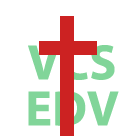
Our liturgical year begins with Advent (which starts either the last Sunday of November or the first one of December) and ends with the Reign of Christ at the end of November the following year.
To cover most of the Bible, the lectionary spans over a three-year period. Hence years A, B and C.
If you want to know which year we are in:
Look at which today's date (and year): |
Today is: December 22nd, 2025 (according to the server time) |
Find what year it was last November 27th: |
2025 |
Divide the year number by 3 |
2025 ÷ 3 = 675 r. 0 |
So the remainder tells us which year it is: 0 –> year A 1 –> year B 2 –> year C |
We are currently in Year A |

One synoptic Gospel is mainly used for each year, so:
… with the Gospel according to John used throughout the three years.
Other readings are usually chosen so they fit with the theme of the Gospel reading.
To find the readings for any Sunday, please visit the
Revised Common Lectionary (when there are two options for Old Testament readings, choose the first one).
Here are the main Seasons of the year:
Advent is made of four Sundays before Christmas (so the last "week" of Advent may be as short as one day). It starts on the Sunday that falls between November 27th and December 3rd.
Christmas season starts with Christmas Eve. In theory it ends with Epiphany on January 6th.
As it is Winter recess, no lessons are provided.
The season starts with Epiphany itself and ends just before Lent on Shrove Tuesday.
The first Sunday after Epiphany (i.e. between January 7th and 14th) is also known as The Baptism of the Lord, and there may be between three and nine Sundays after Epiphany before the concluding one.
The last Sunday after Epiphany is also known as the Transfiguration.
Lent starts with Ash Wednesday and is made of 40 days, excluding Sundays. Therefore, there are six Sundays in Lent. The last one, also known as Palm Sunday or sometimes Sunday of the Passion has two Gospel readings. We generally provide a lesson for the triumphant entry into Jerusalem.
The season starts with the Easter Vigil and ends with Ascension Sunday, on the seventh week of the Easter season. One interesting factor is that weeks are numbered as “weeks of Easter” rather than “weeks after the day of Easter”.
The season of Pentecost is by far the longest. It starts with Pentecost Sunday, followed by Trinity Sunday. Readings and lessons for Sundays thereafter are defined by date, such as “Sunday between June 5th and June 11th”. A few considerations:
Share the good news! Share this page address with your friends and acquaintances!
Partagez la bonne nouvelle !
Transmettez l’adresse de cette page à vos amis et à vos connaissances.
©2012-2015; The Virtual Church School programme
Updated on: 2013-09-02